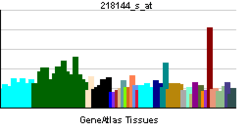INF2
Inverted formin-2 is a protein that in humans is encoded by the INF2 gene.[3][4] It belongs to the protein family called the formins. It has two splice isoforms, CAAX which localizes to the endoplasmic reticulum and non-CAAX which localizes to focal adhesions and the cytoplasm with enrichment at the Golgi.[5][6][7] INF2 plays a role in mitochondrial fission and dorsal stress fiber formation.[7][8] INF2 accelerates actin nucleation and elongation by interacting with barbed ends (fast-growing ends) of actin filaments, but also accelerates depolymerization of actin through encircling and severing filaments.[9]
Clinical significance
It can be associated with Focal segmental glomerulosclerosis[10] and Charcot-Marie Tooth Disease.[11]
References
- ↑ "Human PubMed Reference:".
- ↑ "Mouse PubMed Reference:".
- ↑ Chhabra ES, Higgs HN (Sep 2006). "INF2 Is a WASP homology 2 motif-containing formin that severs actin filaments and accelerates both polymerization and depolymerization". J Biol Chem. 281 (36): 26754–67. doi:10.1074/jbc.M604666200. PMID 16818491.
- ↑ "Entrez Gene: C14orf173 chromosome 14 open reading frame 173".
- ↑ Ramabhadran, Vinay; Korobova, Farida; Rahme, Gilbert J.; Higgs, Henry N. (2011-12-01). "Splice variant-specific cellular function of the formin INF2 in maintenance of Golgi architecture". Molecular Biology of the Cell. 22 (24): 4822–4833. doi:10.1091/mbc.E11-05-0457. ISSN 1939-4586. PMC 3237625
 . PMID 21998196.
. PMID 21998196. - ↑ Chhabra, Ekta Seth; Ramabhadran, Vinay; Gerber, Scott A.; Higgs, Henry N. (2009-05-01). "INF2 is an endoplasmic reticulum-associated formin protein". Journal of Cell Science. 122 (Pt 9): 1430–1440. doi:10.1242/jcs.040691. ISSN 0021-9533. PMC 2721004
 . PMID 19366733.
. PMID 19366733. - 1 2 Skau, Colleen T.; Plotnikov, Sergey V.; Doyle, Andrew D.; Waterman, Clare M. (2015-05-12). "Inverted formin 2 in focal adhesions promotes dorsal stress fiber and fibrillar adhesion formation to drive extracellular matrix assembly". Proceedings of the National Academy of Sciences of the United States of America. 112 (19): E2447–2456. doi:10.1073/pnas.1505035112. ISSN 1091-6490. PMC 4434736
 . PMID 25918420.
. PMID 25918420. - ↑ Korobova, Farida; Ramabhadran, Vinay; Higgs, Henry N. (2013-01-25). "An actin-dependent step in mitochondrial fission mediated by the ER-associated formin INF2". Science (New York, N.Y.). 339 (6118): 464–467. doi:10.1126/science.1228360. ISSN 1095-9203. PMC 3843506
 . PMID 23349293.
. PMID 23349293. - ↑ Gurel, Pinar S.; Ge, Peng; Grintsevich, Elena E.; Shu, Rui; Blanchoin, Laurent; Zhou, Z. Hong; Reisler, Emil; Higgs, Henry N. (2014-01-20). "INF2-mediated severing through actin filament encirclement and disruption". Current biology: CB. 24 (2): 156–164. doi:10.1016/j.cub.2013.12.018. ISSN 1879-0445. PMC 3992431
 . PMID 24412206.
. PMID 24412206. - ↑ Brown EJ, Schlöndorff JS, Becker DJ, Tsukaguchi H, Uscinski AL, Higgs HN, Henderson JM, Pollak MR (Jan 2010). "Mutations in the formin gene INF2 cause focal segmental glomerulosclerosis". Nature Genetics. 42 (1): 72–6. doi:10.1038/ng.505. PMC 2980844
 . PMID 20023659.
. PMID 20023659. - ↑ Boyer, Olivia; Nevo, Fabien; Plaisier, Emmanuelle; Funalot, Benoit; Gribouval, Olivier; Benoit, Geneviève; Huynh Cong, Evelyne; Arrondel, Christelle; Tête, Marie-Josèphe (2011-12-22). "INF2 mutations in Charcot-Marie-Tooth disease with glomerulopathy". The New England Journal of Medicine. 365 (25): 2377–2388. doi:10.1056/NEJMoa1109122. ISSN 1533-4406. PMID 22187985.
Further reading
- Kimura K, Wakamatsu A, Suzuki Y, et al. (2006). "Diversification of transcriptional modulation: Large-scale identification and characterization of putative alternative promoters of human genes". Genome Res. 16 (1): 55–65. doi:10.1101/gr.4039406. PMC 1356129
 . PMID 16344560.
. PMID 16344560.
- Bindschadler M, McGrath JL (2004). "Formin' new ideas about actin filament generation". Proc. Natl. Acad. Sci. U.S.A. 101 (41): 14685–6. doi:10.1073/pnas.0406317101. PMC 522045
 . PMID 15466701.
. PMID 15466701.
- Fu GK, Wang JT, Yang J, et al. (2005). "Circular rapid amplification of cDNA ends for high-throughput extension cloning of partial genes". Genomics. 84 (1): 205–10. doi:10.1016/j.ygeno.2004.01.011. PMID 15203218.
- Gevaert K, Goethals M, Martens L, et al. (2004). "Exploring proteomes and analyzing protein processing by mass spectrometric identification of sorted N-terminal peptides". Nat. Biotechnol. 21 (5): 566–9. doi:10.1038/nbt810. PMID 12665801.
- Strausberg RL, Feingold EA, Grouse LH, et al. (2003). "Generation and initial analysis of more than 15,000 full-length human and mouse cDNA sequences". Proc. Natl. Acad. Sci. U.S.A. 99 (26): 16899–903. doi:10.1073/pnas.242603899. PMC 139241
 . PMID 12477932.
. PMID 12477932.
- Venter JC, Adams MD, Myers EW, et al. (2001). "The sequence of the human genome". Science. 291 (5507): 1304–51. doi:10.1126/science.1058040. PMID 11181995.
- Suzuki Y, Yoshitomo-Nakagawa K, Maruyama K, et al. (1997). "Construction and characterization of a full length-enriched and a 5'-end-enriched cDNA library". Gene. 200 (1–2): 149–56. doi:10.1016/S0378-1119(97)00411-3. PMID 9373149.
- Maruyama K, Sugano S (1994). "Oligo-capping: a simple method to replace the cap structure of eukaryotic mRNAs with oligoribonucleotides". Gene. 138 (1–2): 171–4. doi:10.1016/0378-1119(94)90802-8. PMID 8125298.

 . PMID 21998196.
. PMID 21998196. . PMID 19366733.
. PMID 19366733. . PMID 25918420.
. PMID 25918420. . PMID 23349293.
. PMID 23349293. . PMID 24412206.
. PMID 24412206. . PMID 20023659.
. PMID 20023659. . PMID 16344560.
. PMID 16344560. . PMID 15466701.
. PMID 15466701. . PMID 12477932.
. PMID 12477932.